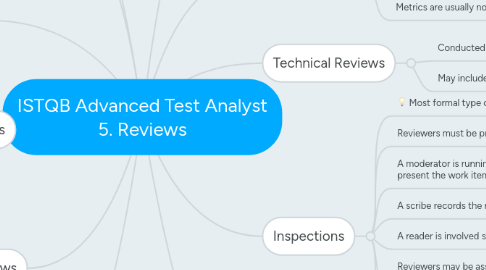
1. Audits
1.1. The most formal of the review types
1.2. The least effective at finding defects
1.3. Conducted by independent group(external engagement) with lead auditor
1.4. Auditing team...
1.4.1. determines compliance with specified expectations
1.4.2. perform interviews, observation, exam available documents
1.5. result in...
1.5.1. recommendations for change
1.5.2. list of corrective actions
1.5.3. pass/fail assessment
2. Contractual Reviews
2.1. are associated with a particular contract milestone and conducted to verify adherence to the contract criteria
2.2. Include a management review
2.3. Involve managers, customers, and technical staff working on the project
2.4. Frequently used on large systems or safety-critical systems
3. Requirements Reviews
3.1. Provide one of the highest ROI
3.2. Maybe an informal walkthrough, a technical review, or a formal inspection
3.3. Participants should include all project stakeholders
4. Design Reviews (DR)
4.1. DR are usually technical reviews or formal inspections between peers
4.2. Customers and users may be included
4.3. Reviewers must have technical knowledge
5. Acceptance/Qualification Reviews
5.1. Used to obtain management approval for the system that has been or is still being developed
5.2. Conducted as management reviews or audit
6. Operational Readiness Review
6.1. Done prior to deployment
6.2. includes the review of operational procedures such as backups and other capabilities of the product
7. Informal Reviews
7.1. Conducted by author and selected set of reviewers
7.2. Participants go through the doc and suggest improvements
7.3. Author make notes and responsible for making the changes
7.4. Pros and Cons
7.4.1. Most commonly used & Fast & Effective
7.4.2. Metricts gathered rarely and contribution to process improvement is small
8. Walkthroughs
8.1. Author is leading the discussion
8.2. Author make notes and responsible for making the changes
8.3. Metrics are usually not tracked
9. Technical Reviews
9.1. Conducted by technically oriented reviewers
9.2. May include a moderator
10. Inspections
10.1. Most formal type of INTERNAL reviews
10.2. Reviewers must be prepared before
10.3. A moderator is running the review and present the work item
10.4. A scribe records the notes
10.5. A reader is involved sometimes
10.6. Reviewers may be assigned to a type of defect(e.g. security, performance) to look for
10.7. Metrics are mandatory
10.7.1. Number of defects found
10.7.2. Types of defects
10.7.3. Issues to be considered for process improvement
11. Management Reviews
11.1. Used to ...
11.1.1. Review the project or it's parts to assess the progress
11.1.2. Get the status
11.1.3. Verify deviations from plans
11.1.4. Review project risks and mitigation plans
11.2. Conducted ...
11.2.1. By or for managers that directly responsible for the project
11.2.2. In some cases, stakeholders or upper management
11.3. Produces a list of action items
12. 6 Phases for Formal Review
12.1. 1. Planning
12.1.1. Training the reviewers
12.1.2. Getting management support
12.2. 2. Kick-off
12.2.1. Having the initial meeting
12.3. 3. Individual Preparation
12.3.1. Read the work product and prepare comments
12.4. 4. Review Meeting
12.4.1. Conducting actual meeting
12.5. 5. Rework
12.5.1. Changes should be made by author
12.6. 6. Follow-up
12.6.1. Re-review if required
12.6.2. Gathering suggestions for improvement
